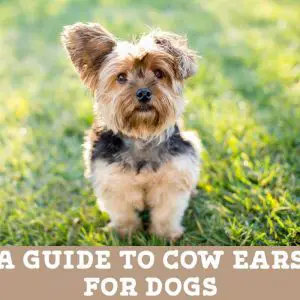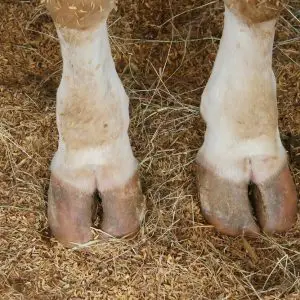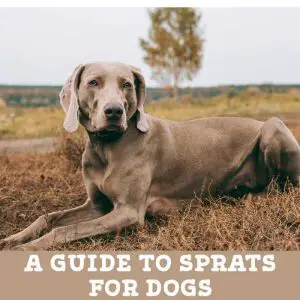Beef tails fro dogs are growing in popularity as a tasty snacks. They are high in protein, low in fat and very moreish according to our dogs. But what exactly are beef tails? Are they safe for our dogs? What are the pros and cons of feeding them? This article will aid you in deciding if they are the right snack for you and your dog. Read on to find out more.
Key facts
Beef tail chews are made by dehydrating the tail section of a cow. They are a natural product with no additives or preservatives.
Beef tail chews are a useful way of encouraging healthy chewing habits for your dog. They may also help maintain good dental health.
Beef tail chews are high in calories and therefore should only be used as a treat, not a routine part of your dog’s diet.
Risks of feeding beef tail chews include bacterial contamination, digestive irritation, gastrointestinal blockages and choking.
Some popular alternatives to beef tail chews are dental chews, bully sticks, animal hooves and deer or elk antlers.
What Are Beef Tails?
Beef tails are natural chews comprised of the cow’s tail, including the bone and cartilage and the surrounding skin. They are usually dehydrated or dried naturally.
They are a popular choice of chew for dogs as they usually are long-lasting, with a high protein, and low-fat ratio and are gluten and grain free.
They are typically 100% natural with no preservatives or additives however individual manufacturers will vary. They are usually sold in 6-inch lengths, although being a natural product, there are some variations in length and width.
The tail contains bones of the vertebrae surrounded by connective tissue and skin. The outside has a tough texture and they are crunchy on the inside. They are best purchased for medium-sized dog breeds.
Provenance
Beef tails, as the name suggests, come from the tail of beef cattle. Beef tail is used widely in various different recipes, usually slow-cooked in soups or stews and is often described as a ‘forgotten cut’. The main producers of beef products in Europe are France, Germany, Italy and Spain. There are other manufacturers from further afield including the USA and Australia.
Food safety standards will vary greatly depending on the country of origin so bear this in mind when choosing your product. Animal welfare practices will vary too. Look for products which have been approved by associations such as RSPCA Freedom Food Standards, Red Tractor, the Soil Association and Scottish Organic Producers Association. When searching for a suitable product for your pet, it is best to try wherever possible, to source locally.
Preparation
Beef tail chews are made from drying sections of the tail of a cow. They are usually dried out using a slow baking method or dehydrated in batches at low temperatures over a long period of time.
Beef tail chews vary slightly in appearance depending on the method they have been dehydrated by and also which section of the tail has been used. Some will be a lot thicker in width if taken from higher up the tail.
RAW feeding
Did you know?
If your dog is on a raw diet, beef tail chews can be included as an addition to their normal meals. It is always advised to maintain excellent hygiene practices including washing hands after any contact and cleaning down surfaces with appropriate cleaning products. This is due to the fact that, as with any raw feeding practices, there is always a risk of exposure to dangerous bacteria such as Salmonella, E. Coli, listeria and campylobacter. Your dog may not become unwell with exposure to any of these pathogens, however, there is a big risk of significant illness to any humans in the household. Especially any who are immunocompromised, and any younger children or elderly individuals.
Benefits of Beef Tails for Dogs
Key benefits
Dental Health
It is thought that encouraging healthy chewing habits may aid in the removal of plaque and tartar.
Mental Stimulation
Chewing keeps your dog occupied and may help to reduce boredom and stress.
Nutritional Benefits
Beef tail chews are very nutritious with a high protein content and contain many vital vitamins and minerals required for good health.
Single Protein Source
If your dog suffers from allergies, you can ensure they are only being exposed to beef protein with these chews as they only contain one single source of protein.
Oral and dental health
Beef tail chews are thought to aid in keeping a dog’s teeth clean naturally. The tough, hard bone and cartilage provide a durable, crunchy texture that is thought to mechanically debride plaque and tartar from the teeth. There isn’t currently any research to prove that beef tail chews are effective at keeping teeth clean.
The benefits will also largely depend on how long it takes your dog to consume the chew, if this occurs rapidly, the benefits will be short-lived or non-existent. No chews or food products should ever replace the usual recommended dental care – regular brushing of the teeth and frequent checkups with your vet.
Mental stimulation
Recreational chewing is normal healthy behaviour for our dogs and it is an important part of their scavenging process when they are hunting for food. It is instinctive for our dogs, therefore if we encourage it in a safe way that does not damage their mouths or our property – everyone is a winner.
Chewing keeps our dogs occupied and reduces boredom and relieves stress. It also exercises their jaw muscles and keeps them strong.
Nutritional Benefits
Beef is a brilliant option for our dogs. It is extremely nutritious and easy to digest. Beef contains important minerals such as zinc, phosphorus, selenium and iron. Beef is also known to contain B vitamins such as B12, B6 and B3.
Single Protein source
Some dogs are allergic to certain animal proteins that are found in their food. It can be difficult to know what to feed dogs with allergies as some foods may contain small or trace amounts of proteins they are allergic to. If you know that your dog isn’t allergic to beef, beef tail chews are a really good option as you can guarantee they don’t contain any traces of other proteins.
Nutritional Information for Beef Tail Chews
Nutrients
Note: composition will vary depending on the manufacturer, mode of dehydration, and each batch.
Protein
Beef tail chews contain a high amount of protein. Protein is vital for the healthy growth and development of your dog. It provides essential amino acids which contribute to muscle development, tissue repair and healthy skin and coat amongst other things.
Most dogs thrive on a high-protein diet although it is always best to consult your vet before giving high-protein treats. Some conditions such as kidney or liver disease may be exacerbated by a high-protein diet.
Fat
Beef tail chews are usually popular as they boast low amounts of fat. The issue is that the fat content isn’t particularly consistent so depending on the brand and the method of dehydrating, the fat content varies. It’s important to do your own research and check the label of the product you are looking to purchase to ensure low-fat content.
If your dog is obese or suffering from diabetes or prone to pancreatitis flare-ups, beef tail chews may not be suitable – always check with your vet before introducing new treats if your dog has an underlying health condition.
Vitamins, Minerals and Compounds
Vitamins and Minerals
Iron is important for transporting oxygen in the haemoglobin of red blood cells to all the muscles and vital organs in your dog’s body.
Zinc plays an important role in the function of enzymes, hormones and proteins. Zinc is vital for a healthy immune system and a zinc deficiency may result in your dog’s immune response being compromised.
Phosphorus is a vital mineral that is required for the maintenance of healthy bones, teeth and a healthy metabolism.
Selenium is a microelement which is important for a healthy functioning metabolism.
Vitamin B12 is important for the correct functioning of a healthy nervous system.
Vitamin B3 is important for the maintenance of healthy skin and nerves.
Vitamin B6 is needed for the generation of glucose, correct functioning of the nervous system and hormone regulation.
All these nutrients are important and very useful, however, there are no current studies to confirm that beef tail chews are a reliable source of these nutrients or indeed could be used as a supplement to ensure your dog is getting the recommended amount.
There is no research to confirm if there is a high enough concentration to have a positive impact on your dog’s health. It is always best to consult your vet if you feel your dog is lacking in any nutrients. It is also important to ensure your dog is getting a balanced diet as that is the best way to ensure they are receiving the correct nutrition.
Do Not Overfeed
Beef tail chews are relatively high in calories. Calorie content will vary depending on the size of the treat. This means each chew contains approximately 204 kcal/treat. This could end up being a large percentage of your dog’s calorie intake – for a practical example, a 10 kg dog would require between 560 – 750 kcal/day. Be careful not to overfeed your dog with chews.
| Calories 3500-4000 kcal/kg |
Feeding Guide
Beef tail chews should always be viewed as an additional extra to your dog’s diet, not as a replacement for their usual dog food. Beef tail chews are recommended as a treat, not a daily part of your dog’s diet. This is due to the fact they contain a high amount of calories. One chew 1 to 2 times a week would be enough for a small breed dog.
If your dog is overweight or suffers from conditions such as diabetes or pancreatitis, it is best to avoid them completely or consult with your vet before considering them.
Downsides & Risks of beef tail chews for Dogs
| Summary of risks – The main risks for beef tail chews that owners need to be aware of are bacterial contamination, digestive irritation, choking hazard and gastrointestinal obstruction. |
Beef tail chews are not without risks. Most are minimal and uncommon however they can still be serious. It is important for owners to be aware.
Bacterial Contamination
Beef tail chews and indeed any raw meat product comes with a risk of contamination with dangerous bacteria. These include E. coli, Listeria and Salmonella. Most dogs won’t be severely affected by these pathogens, however all of these can cause significant disease in humans. In particular young infants, elderly people and anyone immunosuppressed.
Steer clear of beef tail chews and seek out an alternative dog treat if –
- Your dog is going to come into contact with anyone in the above categories
- Your dog has underlying health issues that may affect their immune system
It is always advised to ensure proper hand washing after handling any of these products and to clean down any surfaces in contact with appropriate disinfectant.
Choking hazard
Due to the composition of beef tail chews, they pose a choking hazard to your dog. Beef tail chews contain bones, cartilage and connective tissue. Parts of the chew are incredibly tough and may splinter leaving sharp sections. Segments of the chew can become stuck at the back of your dog’s throat or even lodged in your dog’s airway, causing choking and breathing difficulty.
If your dog is a speedy chewer and often bites through chews, it is probably best to steer clear of beef tail chews.
Digestive Irritation
Some dogs may be more sensitive or even allergic to beef tail chews. All dogs will tolerate different amounts of the chew in different ways. If your dog doesn’t tolerate them well, or eats too many of them, this can cause symptoms such as vomiting or diarrhea.
Gastrointestinal Obstruction
If your dog swallows large pieces of the chew, they may become lodged in any part of their digestive tract. Any obstruction can be fatal if left untreated. Sometimes sharp pieces of bone perforate the guts, this is a medical emergency and your dog may be at risk of losing their life.
Some dogs try to swallow the entire chew whole, this can also cause damage or obstruction. Ensure the size of the beef tail chew is appropriate for your dog, larger breeds may be suited to a more substantially sized chew to prevent them swallowing them whole.
Avoid If…
- Your dog is likely to try and swallow the chew whole
- Your dog is obese
- Your dog suffers from diabetes or is prone to pancreatitis flare ups.
- Your dog has underlying health issues and/or is immunosuppressed (for example receiving chemotherapy)
- Your dog has an allergy to beef products.
| Beef Tail Chew for Puppies The guidelines for minimum age of feeding beef tail chews varies depending on the manufacturer. Most of them state from 12 – 16 weeks although others say 6 months of age. As puppies under 6 months old will have sensitive, delicate puppy teeth, it is best to avoid them under this age. As a treat high in calories, it is recommended to only feed infrequently to puppies, once every few weeks. You must also be careful with how much extra calcium your dog is receiving, if there is too much calcium in their diet, this can cause skeletal malformations and secondary nutrient deficiencies. You must always supervise your puppy when giving them chews. Puppies often enjoy beef tail chews when they are teething. They are also a good way to keep them mentally stimulated. They offer a less expensive alternative to them chewing your furniture! |
Alternatives to Beef tail chews
- Hooves – horse, pig and cattle hooves are available as chews for dogs. Some owners prefer these as due to the shape they are harder for dogs to splinter and swallow small spikey parts. Ensure that you pick a size appropriate for your dog that they won’t be able to swallow whole and choke.
- Edible Dental Chews. There is a huge market for digestible dental chews and a very wide variety of products available. They are usually made from potato starch and are flavoured. Plenty are vet approved so it’s important to shop around to find one that is safe for your dog. The Veterinary Oral Health Council have a list of recommended products. Beware, although dental chews do help with dental hygiene, they are incredibly high in calories and can cause dramatic weight gain if given everyday.
- Antlers. These are natural antlers that have been shed from deer or elk. They are extremely tough and don’t often splinter. They are a good alternative for very enthusiastic chewers that normal rawhide chews don’t last very long with. The downside is that they are so tough, some dogs are in danger of breaking a tooth if they chew too hard.
- Bully Sticks. These are natural products made from dehydrating the inner tendon of the penis of a bull. They are a highly digestible alternative. They do, unfortunately, have a very high calorie content and they do also have a strong odour some owners don’t tolerate.
FAQs
- Are beef tail chews good for dogs?
Beef tail chews are considered a good choice for dogs. They are natural, high in protein, and have an interesting texture for your dog. They are good for mechanical debridement of plaque and tartar from your dog’s teeth. Chewing helps your dog exercise their jaw muscles and provides mental stimulation for them.
- Are beef tail chews safe for dogs?
Despite the popularity of the product, beef tail chews aren’t without some risks. There is a risk of bacterial contamination as they are a raw animal product. They can be a choking hazard and they can cause intestinal blockage and obstruction and digestive irritation. It is strongly recommended that you supervise your dog closely when giving them any sort of chews and ensure that you choose an appropriate size that your dog won’t be able to swallow whole.
- Do dogs like beef tail chews?
Dogs do seem to enjoy beef tail chews. Beef tail chews contain hard crunchy cartilage that offers an interesting, chewy texture. Dogs are attracted to the smell too although owners may not be so keen.
- How many beef tail chews can a dog have?
Dogs should be limited with the number of beef tail chews they have. Beef tail chews are relatively high in calories so it is recommended to only give them to your dog once or twice a week as a special treat as opposed to every day as part of their diet. If your dog is obese or has health issues such as pancreatitis or diabetes, it is best to choose an alternative snack due to the amount of extra calories they would be consuming.
- How long do beef tail chews last?
How long beef tail chews last does depend entirely on your dog and how much of an avid chewer they are. It does also depend on their breed. Smaller dogs may take up to an hour to finish a chew whereas larger breeds may only take ten minutes. It is so important to supervise them for the duration of the chew, regardless of how long it takes them.
- Can beef tail chews cause a blockage?
Yes, beef tail chews can cause an intestinal blockage. If your dog swallows a large segment or even the whole chew, it can become lodged somewhere along their digestive tract and cause a serious blockage. If this occurs it is a medical emergency and you need to seek veterinary attention.









